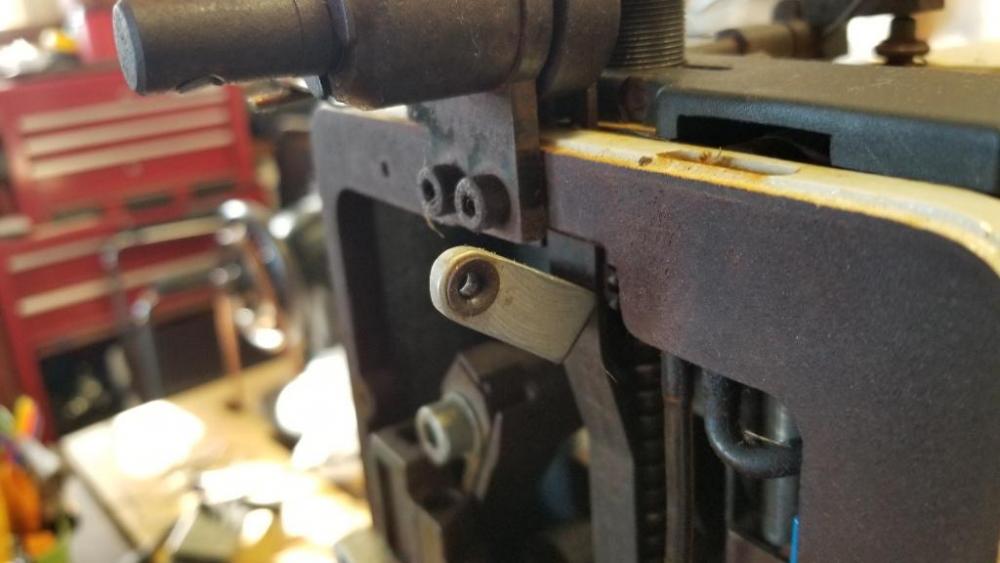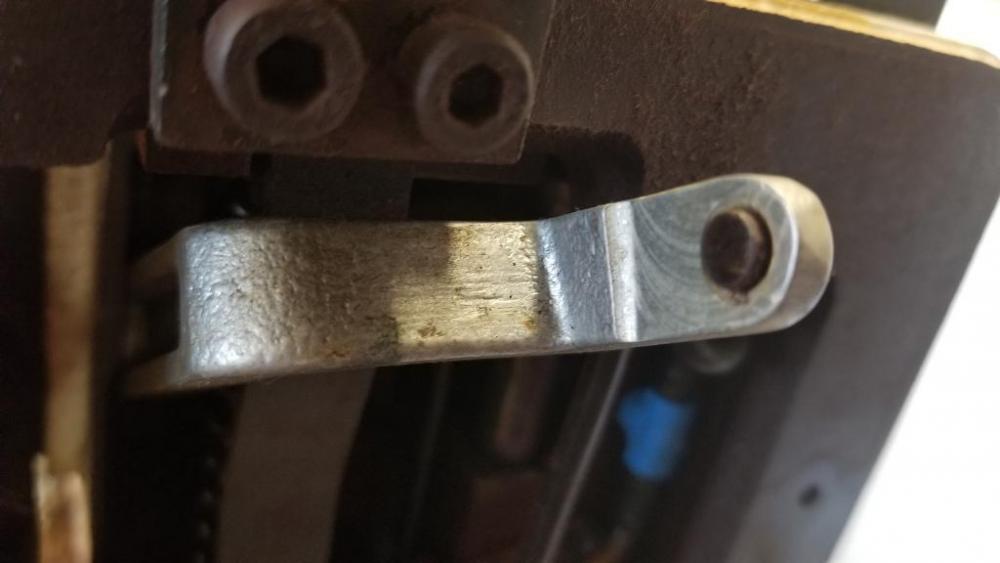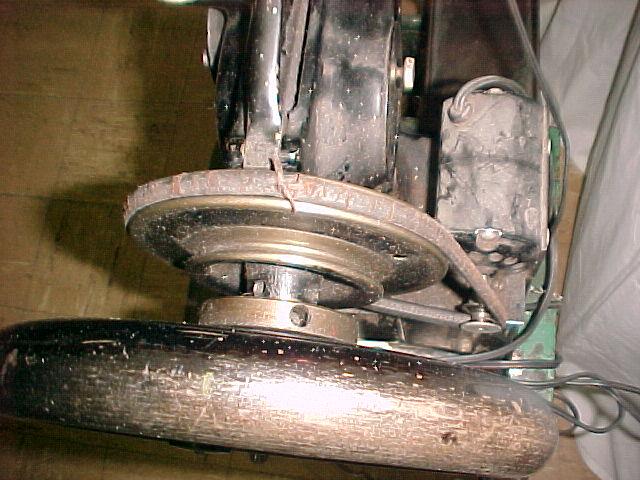-
Posts
483 -
Joined
-
Last visited
Content Type
Profiles
Forums
Events
Blogs
Gallery
Everything posted by cdthayer
-

Should my 227R-2 be releasing the upper tension at any point?
cdthayer replied to williaty's topic in Leather Sewing Machines
Watch the video in this thread. CD in Oklahoma -

Should my 227R-2 be releasing the upper tension at any point?
cdthayer replied to williaty's topic in Leather Sewing Machines
It's some of that "Fake News" that you hear about all of the time. Harry and Youtube will leave that fake news video up from now on, steering folks wrong... CD in Oklahoma -

Should my 227R-2 be releasing the upper tension at any point?
cdthayer replied to williaty's topic in Leather Sewing Machines
It does? CD in Oklahoma -
I don't know Bert. Could be. CD in Oklahoma
-
Thanks Wiz, It makes sense to have a user-replaceable eyelet system on this machine for when repeated thread use wears a groove in the eyelet. User-replacement would probably eliminate a flaring tool to install a new eyelet, so I’m suspecting a two-piece press-together replacement. I just don’t have a good clear photo of that side of the eye to see if I’m now missing half of it. This may be a good question to fire at Allen over at Weaver Sewing, but with all of the Adler 205-370 owners on this forum, maybe someone will chime in. The back side of the take-up lever can be seen and photographed full-travel through a slot without removing the end cover. I just can’t seem to find a close-up photograph of it anywhere. CD in Oklahoma PS- Can you remove the duplicate image in my previous post? It won't let me kick it out.
-
I got the 4 new springs installed in the race. That was kind of an adventure, but no blood-letting. I still have my thread-shredding problem, and I’m honing in on the take-up lever as the possible problem now. I finally took the end cover off to see what was going on in there, and my thread (Tex350 Poly) was being shredded coming into the take-up lever. The grommet in the lever eye has a nice large flange on the exit side, but the entrance side is small, not flared, and sort of sharp. I’m wondering if it originally was a two-piece press-together grommet, and half of it fell apart during a thread change? I’m just thinking out loud now. That could explain why it sewed fine and then suddenly wouldn’t. The machine will make a couple of stitches, and then bind up and miss the subsequent stitches. If the thread is being held at the take-up lever, there wouldn’t be any loop for the hook to pick up. This is a late 1990s machine. Can anyone give me some advice on this, or maybe post a photo of the back side (away from the operator) of your take-up lever eye? CD in Oklahoma
-
That sounds like a 15x1 (or 130/705) needle. I've never tried one in my 96-40. CD in Oklahoma
- 13 replies
-
- industrial sewing machines
- sewing machine repair
-
(and 1 more)
Tagged with:
-
Are you using a 16x257 needle in it? CD in Oklahoma
- 13 replies
-
- industrial sewing machines
- sewing machine repair
-
(and 1 more)
Tagged with:
-
I equate a re-paint and installation of new decals on an old sewing machine to years past (1970s?) of guys putting chrome valve covers on an old car. “Flippers” have been doing that to cars for years. It doesn’t usually make it work any better (even when adding the chrome oil filler pipe vented cover cap didn’t seem to make the car perform any better. It still smoked and burned oil), but flippers seemed to think that it made the car more valuable. When I see a repaint sewing machine, I think, “Oh, oh, what’s wrong with this machine?” Keep the old decals that show a history of the machine. It’s been through some hard times and survived. Let it tell its story. CD in Oklahoma
-
@Glenn, your compliment on Weaver Leather Supply for Adler parts is well founded. I haven’t ever contacted Allen personally, but the company has some great folks working there. I got my springs fast, fast just by ordering on their website! My new springs are ready for installation when the ambient temperature goes down a little here in Oklahoma (we’re in a “Flash Drought”, and I have no cooling in my sweat shop of a sewing room). FWIW - I hadn’t ever heard of the term “Flash Drought” before, but looking it up, it seems that if the conditions turn extremely hot with no rain after a period of very wet conditions, the ground conditions can be dried out extremely fast, and qualifies as a “Flash Drought” (sort of like a “Flash Flood” that comes with too much rain in a short period of time). I’m not complaining about the weather. It gets hot in Oklahoma during the summer. We’ve had triple digits for several days with little end in sight. At my age, I’ll take the heat over the cold. On another note: one time previous, a few months ago, I chatted with a young lady about parts for my Adler 205-370, and while she didn’t know the answer to one of my questions, she told me so, and was right back on the chat with the solution that the other folks at Weaver gave her. They do bust their hump to help us out here in the wild. It’s not cheap to be an Adler owner that needs to buy parts, and getting past the cost may be difficult for some, but Weaver makes it as painless as they can by giving good service. CD in Oklahoma
-
I have a 1936 Singer 96-40. What kind of repairs does your machine need? CD in Oklahoma FYI - The parts manual for it is at http://parts.singerco.com/IPpartCharts/96-3_10_12_16.pdf
- 13 replies
-
- industrial sewing machines
- sewing machine repair
-
(and 1 more)
Tagged with:
-
That was an error. I should have said 1/4" round leather belting. CD in Oklahoma
-
One of the Singer 29K70 machines that I have came to me with a household sewing machine motor fitted to it. Actually, it worked fairly well for fabrics and thin leathers, which is about all that the 29-series is good for sewing anyway. They had mounted the motor on a small piece of thin angle iron screwed to the shoulder of the head, and ran a 3/16-inch round leather belt on it. The basic household foot control was mounted with one screw onto the top of the normal 29-style treadle stand under the machine pillar, had a hole drilled in the foot pedal, and had a small chain attached down to the original treadle stand foot plate. I believe that my motor was a Dayton, but I can’t seem to locate any photos of its nameplate, and no telling where the motor is now. I stripped it all off of the machine immediately and converted it back to treadle years ago. The problem that you may run into is the pulley size on the replacement household motor. It seems like it needs to be as large as the pulleys on the 29K in order to avoid belt slippage. Maybe you can use the pulley off of the old motor? My Dayton motor had a pulley on it that matched the pulleys on the machine head, and was wider/deeper than normal household pulleys, so the 3/16” belting worked fine. CD in Oklahoma
-
I don't have one of that model machine, so I'm not familiar with the hook assembly, but is there any adjustment in and out (closer/further from the needle) on it? CD in Oklahoma
-
Thanks Glenn.
-
Good question. I've worked on a lot of purses (repairs) and have never paid much attention to which way the zipper was oriented. But for a builder, that could be an important consideration. Thanks for the question! CD in Oklahoma
-
I’m in the same boat with you, and share your frustration. My Adler 205-370 was sewing just fine in May, both on leather and woven samples, then, I didn’t use it until mid-July. Now, it shreds the thread on the third stitch (bonded Tex350 poly thread top and bottom, 7x3-26 round-point needle), and misses the fourth and beyond stitches. The needle even sews through the upper thread at times. Nobody has been around it, and I haven’t changed a thing except to unthread the upper thread while I wasn’t using it. I haven’t touched the bobbin thread. I threaded it back up on top, and the problem started. I threaded it with a different spool of thread. Same thing. I can't figure out WHAT I'm doing different! AAAAARGGGG!!!!! CD in Oklahoma
-
Who can sell me the springs (part # 068 00 183 0)? Contact me. CD in Oklahoma
-
mikesc, I’ve been here on leatherworker.net for a while, and maybe I haven’t given a huge amount of help, but I’ve helped when I could. I’m probably not “bump daily” material, but what would you think would be a good schedule for me to bump my “for sale” items up? Every other day? Every two days? Twice a week? Once a week? Every couple of weeks? Once a month? And what about all of the other folks that have things for sale here? They might be interested in you deciding what their schedules should be too. CD in Oklahoma
-
You have a Singer 211G156 with a thread lube system on it? Do you have any photos? CD in Oklahoma
-

When can you call yourself a craftsman?
cdthayer replied to Handstitched's topic in Leatherwork Conversation
I hear ya. I’m near to calling myself “proficient” at finding nipped jeans rivets on my floor with my bare feet. I do a lot of repairs on jeans hip pockets, particularly Wrangler, that have rivets. I sew reinforcement denim into the seat of the jeans and reattach the pocket and install a new rivet. I’ve said many times that wire fences and hydraulic hoses have helped make me a living for several years. A large man with a large tool in his hip pocket going through/under a fence, or stepping over the drawbar on a piece of equipment that has hanging hydraulic hoses, has way too much forward inertia to stop when that big tool gets hung up, resulting in a torn hip pocket. When I repair the denim jeans, I nip the old rivet off with one of two pairs of nippers that I have, and invariably, once in a while a piece of that rivet gets away from me. I can hear it ricocheting off of the ceiling or walls, but seldom do I see where it actually ends up. It’s small, only half of a rivet, and squished flat to a surprisingly sharp cutting edge by my nippers. Eventually, I find it, using the tried and true “bare foot method”. CD in Oklahoma -

When can you call yourself a craftsman?
cdthayer replied to Handstitched's topic in Leatherwork Conversation
I like to treadle my machines barefooted, but I won’t say what other clothing that I may or may not have on while sewing. Only my shop dog knows, and he ain’t tellin’. But getting back to the main topic of “When can you call yourself a craftsman?”, it’s sort of unfair to compare the term Craftsman of today to the great Al Stohlman of 60 years ago. (I first learned of Al Stohlman when I was around 14 years old (1966) and took leathercraft in 4H. He was already a legend at that time.) We may need to come up with a new definition of “Craftsman” to compare today with bygone years. When it comes to sewing machines, back in 1966, some shops were still using treadles. Real “Craftsmen” learned how to coordinate their feet and hands to be proficient with a treadle sewing machine. Other shops had long switched to clutch motors (1940s) and were enjoying electrification. Boy, can I imagine the excitement when the first clutch motors hit the market! Some treadle operators were no doubt intimidated, while those that weren’t worth a damn at treadling probably then had a shot at employment. Clutch motors went through one improvement after another, making them supposedly easier to control and more efficient (I still think that the early Atlas Clutch Motors were the best.). Operators took great pride in becoming “good” with a clutch motor, and that improved their chances of employment. It was all in the “feathering”, and had to be learned with lots of practice. Speed reducers were added to help with control (reducing the need to be able to feather) and for torque. Then, along came the Servo motors completely eliminating the need for “feathering”. And then came improvements to the servo motors. Then needle positioning and other enhancements to make sewing machines easier to operate. Computerized sewing machines can now do all of the “work” after the operator does a few things to set the machine up, push the button, and wait for the machine to finish. Is a person that selects computer programming to initiate a machine function also a “Craftsman”? We’re getting to be such a “plug-n-play” world now, that the term Craftsman is slowly becoming immaterial. We may need a new term for today’s bragging rights. CD in Oklahoma -

When can you call yourself a craftsman?
cdthayer replied to Handstitched's topic in Leatherwork Conversation
Isn't it amazing how much Plumbers know about sewing? Enough to boggle my mind! I recently did a golf cart seat and backrest job for my local Plumber. He's a younger guy than me and a great plumber that claims he doesn’t know anything about sewing. When I found a shop towel stuffed into the seat cushion of his used golf cart that had been put in by a previous upholsterer to fill the void in one end of the seat where the driver usually sits and the foam had gotten worn away from use with a damaged seat cover, and told him about it, he asked if I'd put the shop towel back in before I stapled the new seat cover on. I told him that of course I did, and he said "Good, it was there for a reason, and I don't want to buy new foam. Good job." Last I heard, he was totally tickled with the new seat covers, but now his batteries had crapped out. There goes $1000 for a new set of batteries....but since it's got totally awesome seat covers and backrest pads on it, I would assume that his wife will allow the purchase of new batteries. I’ll keep you posted.... CD in Oklahoma -

When can you call yourself a craftsman?
cdthayer replied to Handstitched's topic in Leatherwork Conversation
I was going to try to lighten things up by mentioning that a bunch of us have been sort of left out of this conversation about Craftsmen and those that are above by not including the fine work done by the wannabees, shade-tree-sewers, rif-raf stitchers, part-timers, half-fasters, here-hold my-beer-sewers, and village idiots, but I decided not to.... CD in Oklahoma -

Please give your opinion on my sewing machine purchase
cdthayer replied to Louiesdad's topic in Leather Sewing Machines
Thanks for that information. It was news to me. Both of my Adler 205s (Grey 205-64 and White 205-370) have the same throat distance of 12.5 inches. If they were any longer, I couldn’t hand crank them with a steering wheel spinner knob. On the suggested tarp-sewing machines, my days of sewing on big tarps are about over. I can’t walk and carry weight much anymore, and the big tarps take a lot of repositioning to get everything to the needle. CD in Oklahoma





